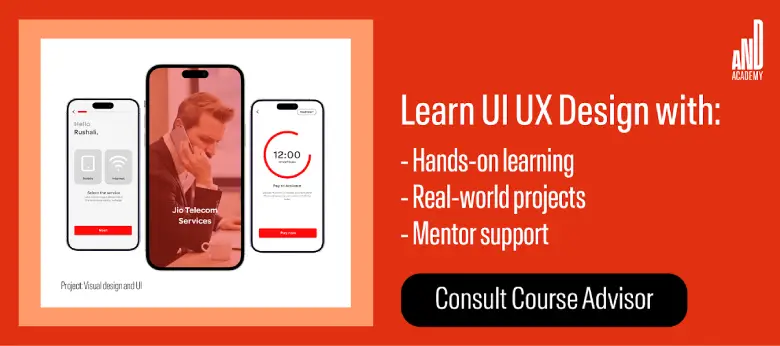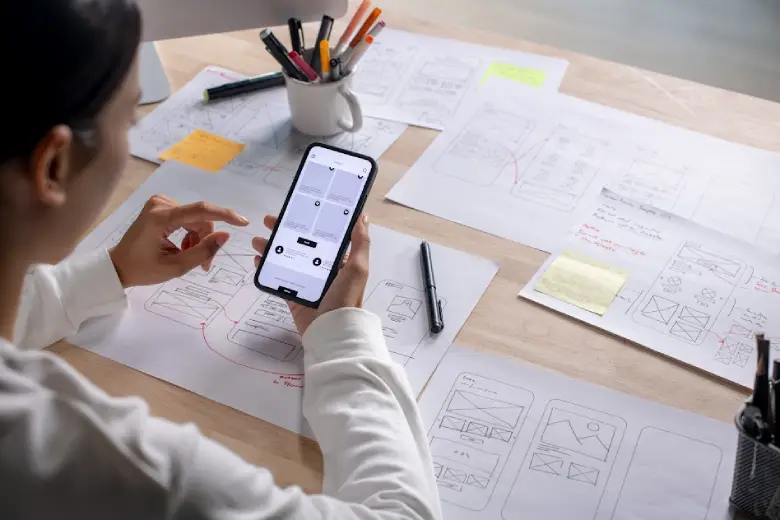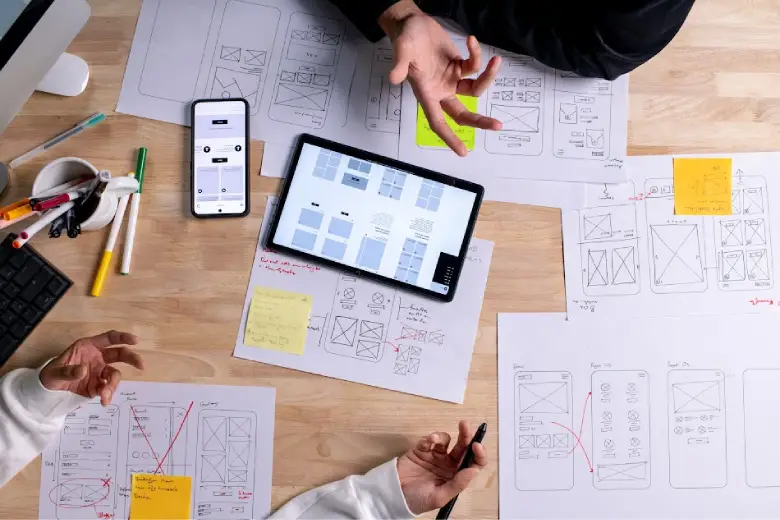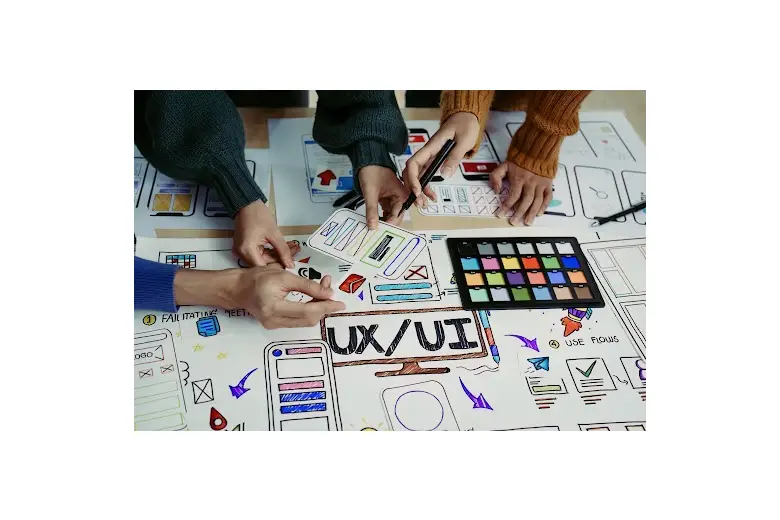What is inclusive design in UX, and how can it benefit users from diverse backgrounds? Learn more about this and how to create a truly inclusive user experience.
Inclusive design is a way of designing products that makes it easier for everyone to use them. By creating such products, businesses can cater to a larger audience pool, ensure people from different backgrounds can easily access and use tech products, and reduce the probability of design issues impacting performance negatively.
More than 1 billion people across the globe have some form of disability, but only 10% have been able to access products. This highlights that around 90% of people with disabilities/impairments face challenges while using mass-market tech products.
In this blog, we will explore everything we need to know about inclusive design and how you can create highly inclusive products that help everyone.

What Is Inclusive Design?
Inclusive design is a design methodology that helps users from diverse backgrounds, disabilities, and locations use products without facing any complications. Inclusive products are usually designed for a user base that covers a wide spectrum of human needs and abilities.
If you miss out on inclusive design principles, you can unintentionally exclude people with special needs or preferences. A researcher or designer with a strong understanding of UI UX design knows the impact this can have on the product and would not overlook it.
Inclusive design, accessibility design, and universal design are often confused with each other. Before you start your inclusive design journey, it is crucial to understand the difference between these three terms.
Accessibility is usually focused on creating user interfaces that can be used by people with disabilities and who need assistive technologies. On the other hand, universal design is about designing products that can be used by people without needing any customizations or assistive technologies and is accommodating of those with disabilities. Inclusive design is similar to universal design in some ways, but finds more application in tech product development. It focuses on creating product experiences that address exclusions such as age, race, gender, language, etc.

Why Does Inclusive Design Matter?
Inclusive design guarantees accessibility, usability, and engagement across diverse users, improving experiences for everyone while inspiring innovation and business success. Here are some other reasons why it matters.
User Perspective:
Check out some of the reasons why inclusive design matters from a user perspective below and how it benefits users with disabilities or impairments.
- Inclusive design helps remove barriers to technology for all people.
- It includes features such as screen readers, voice recognition, and other input methods, allowing everyone to use a product freely.
- It ensures that no user feels left out, and they have the same access as others.
- It brings in broader usability for diverse groups, including aging populations and those in unique environments.
Business Perspective
Let’s explore the most important advantages of inclusive design from a business perspective
- Improved customer satisfaction and loyalty
Inclusive design enhances the overall user experience for apps, in turn improving customer experience, satisfaction, and loyalty. Customers will feel valued and at ease when your apps are inclusive and easy to use. In the long run, users also tend to promote inclusive and accessible brands through word-of-mouth marketing.
- Compliance with ADA and WCAG guidelines
There are a few accessibility standards that you must comply with when building products for a larger audience. Inclusive design follows all these guidelines closely, in turn ensuring your apps are always compliant and that you don’t end up with fines or reputational damage.
- Increased market reach
By adopting inclusive design, you include a vast range of people who were once excluded due to limitations of the products or technologies. Inclusive products cater to a larger audience, which can lead to a bigger market presence and better profitability.

Principles of Inclusive Design
Here are some fundamental principles that serve as the foundation for creating truly inclusive experiences, allowing individuals from different backgrounds, abilities, and perspectives to be involved.
1. Focus on People
When creating an inclusive design, the first and foremost principle is to focus on people. Whether knowingly or unknowingly, we all have biases, and it is important to identify and overcome them to design the most inclusive products.
Focus on the people you want to serve with your products and identify their problems. Objectively research the challenges they face and design your product in a way that helps the users overcome them.
2. Flexibility
This principle focuses on extending solutions of one inclusivity to another by developing products that can be adapted to specific user needs. By following it, you can solve multiple problems through one solution and make your products more accessible. For example, devices with voice-activated assistants can be used by the visually impaired as well as those with motor disabilities. Such products can also be used by individuals without disabilities in certain situations, such as when driving or wanting to read something while cooking.
3. Accessibility
The accessibility principle in inclusive design focuses on keeping your designs standardized and comparable to the WCAG 2.1 guidelines. When you develop designs that meet widely accepted standards, your users will find it easy to interact with your apps, as there will be a uniform user experience delivered through assistive technologies, when needed.
Aging populations often get left behind when technologies advance, leaving them with limited access to tech products. Inclusive design paves the way for them to use tech products through the addition of larger font sizes, simpler interfaces, and voice-assistive technologies.
4. Equity
Another guiding principle in the inclusive design domain is to ensure equity in designs. Whichever design you choose, it should be easy to access for everyone, regardless of their background, location, disability status, etc. Your designs should not be biased toward one section of society and adapt to the varying needs of several groups, in turn ensuring more than just equality.
Steps to Create Truly Inclusive User Experiences
Now that you know the basic principles, let us walk you through the steps one needs to follow to create an inclusive design.

1. Conduct Comprehensive Research
Conduct comprehensive research into your target audience, as well as their usage patterns, likes, dislikes, and challenges, before starting to work on your inclusive design. This will help you know your audience better and understand their requirements clearly.
This step is often the foundation of creating highly accessible user experiences. Also, ensure that your research includes diverse users with different needs so that you can plan inclusivity for as many groups as possible.
2. Incorporate Accessibility from the Start
Once your research is done, aim for the highest accessibility coverage from the start.. This will ensure that your designs are accessible at every point and that you don’t have to make major design changes later to accommodate accessibility needs.
To ensure you are building accessible designs, use things like screen readers, color contrast checkers, and ARIA tools to test your accessibility standings at every stage of development.
3. Design with Flexibility:
When creating an inclusive design, providing flexibility is one of the most important parts. Focus on adaptive layouts that can change based on disability requirements or devices to provide a seamless experience. You should also provide options to scale fonts and multiple ways to interact with the apps to offer various alternatives for use.
4. Test and Iterate:
The best way to know whether you are actually progressing in your inclusive design projects is to test and iteratively fix issues. Do not leave testing for the end; ensure you are doing it at every stage from the beginning, so you can address the issues as they arise.
To test your design’s accessibility, use tools like WAVE and Axe. Also consider letting users give their feedback on the interface, as its often the best way to test real-world usage and fix issues before the release.

Examples of Successful Inclusive Design
Here are some examples of organizations that have cracked inclusive design and enhanced user engagement among diverse groups.
1. Microsoft’s Adaptive Accessories
Microsoft has recently launched a new range of computer accessories aimed at improving the user experience for people with disabilities. These accessories also come with customization options, such as 3D printing extra parts and attaching them to the accessory. Through this, Microsoft is enabling computer usage for people with disabilities and different usage styles, allowing customizations that make accessories more useful and better suited to your needs.
2. Uber’s Safety Settings for Drivers
The world isn’t safe for everyone, and women and non-binary people are often more prone to danger. To make the platform safer for marginalized drivers, Uber has come up with new safety settings for drivers that allow them to set preferences for their pickup requests.
Through this new feature, female drivers can opt to get pickup requests only from other women, making the ride safe for both drivers and riders. This new feature has been successful, according to Uber, and is a great example of inclusive design, which allows people to use products/services without needing to adapt to it.

Challenges in Inclusive Design and How to Overcome Them
Implementation of inclusive design is not always easy and comes with its own set of challenges, ranging from accessibility obstacles to technical limitations. However, these can be overcome through appropriate strategies and solutions. Read on to understand some of these challenges and their solutions.
Common Challenges
- Budget constraints.
Budget constraints are a major challenge in adopting inclusive design. Inclusive design requires a lot of time and effort investment in research and analysis, which naturally increases the overall development costs.
- Lack of awareness or expertise.
Another big challenge in inclusive design is that there isn’t much awareness about the domain yet. So, if you’re looking to adopt it, do make sure to find the right resources. It is also an ever-evolving field, with every year offering new UX design challenges for web designers. Staying up-to-date in this space can be a bit daunting at first, but is almost always worth it.
Solutions
- Train your teams in inclusive design principles
Training your internal teams in inclusive design principles is one of the easiest solutions to combat budget constraints and/or a lack of awareness. This single solution can upskill your teams, help you build accessible solutions, and keep costs for projects under control.
- Leverage open-source accessibility tools and resources
For information about the domain, it is best to use open-source tools and resources. There is always a lot that you can find online with just the right searching skills. Such tools and resources will also validate your progress and guide you on the correct path.
Tools and Resources for Inclusive Design
Having the appropriate tools and resources makes inclusive design easy. Tools like NVDA and VoiceOver can help you test your apps through screen readers and understand how your apps will work with screen-reader software.
If you don’t have significant knowledge and experience about inclusive design, the best resources to look to are the Web Content Accessibility Guidelines and the principles of inclusive design. Both these resources contain everything that you need to design awesome and highly accessible applications.

Emerging trends in inclusive design
Now, you know everything about inclusive design as it looks today, but what about the future? Well, here are some emerging trends that are set to define this space.
1. Voice-Controlled Systems
Voice-controlled systems are on the rise, and they will continue to as more people adopt inclusive designs. Voice-controlled systems help everyone to interact with apps and products using just their voice. This can be especially useful for people who cannot see, touch, or hear, as well as those who have impairments to these senses. Such systems also come with alternative ways for interaction through touch for people with speech impairments or disabilities.
Many organizations are creating smart assistants and voice-controlled bots that take commands from users and do the required work without needing any touch.
2. Assistive Technologies
Assistive technologies are also in demand as more people move to an inclusive design methodology. Navigation apps for visually impaired users are one such example. These technologies provide real-time support to users with disabilities and help them experience products as well as their environment better.
3. Haptic Feedback
Haptic feedback has been around for quite some time now and is a technology that is highly helpful in inclusive designs. Haptic feedback provides vibrations and other ways to relay feedback to users who face difficulties reading or looking at applications. This approach provides feedback accurately and faster, and can also be customized to suit different feedback needs.
4. Promotion of Education on Inclusive Design
Today, there are not enough educational platforms that provide resources to understand inclusive and accessible design, but it is steadily gaining more traction. In the next few years, more and more educational platforms will dive into creating expert content and training in the domain.
Conclusion
As technology evolves to accommodate people from different backgrounds, businesses cannot turn away from inclusive design. We hope this guide helped you understand the nuances of inclusive design and its principles. If designing digital products seems like an ideal career path for you, feel free to check out our UI UX Design courses that provide holistic knowledge of inclusive design principles and the practical experience of building accessible products.
Next Steps
If you’d like to learn more about UX design, head over to the AND Academy Design Blog. You can also check out this project by AND Learner, Vikas Sen, for more insights into the applications of UI UX design.
In case you think you need further assistance, here are some of our resources you can consider:
- Watch this session by Shiva Viswanathan, Design Head of Ogilvy Pennywise, and Naman Singh, Product Experience Designer at RED.
- Talk to a course advisor to discuss how you can transform your career with one of our courses.
- Pursue our UI UX Design courses – all courses are taught through live, interactive classes by industry experts, and some even offer a Job Guarantee.
- Take advantage of our scholarship and funding options to overcome any financial hurdle on the path to your career transformation.
Note: All information and/or data from external sources is believed to be accurate as of the date of publication.









